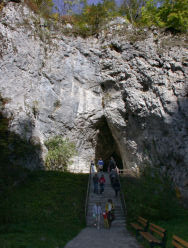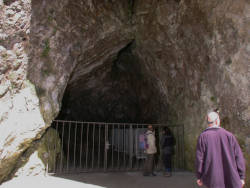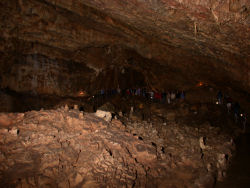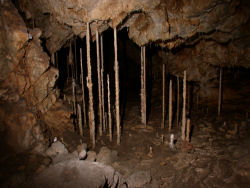Kateřinská jeskyně
Catherine’s Cave
Useful Information


| Location: |
From Brno follow 43 (E461) north to Lipuvka, at the city limits turn right to Blansko, on 379.
At the city limits turn right again, then at the iron works turn left to Skalní mlýn.
In the valley Suchý Žleb, 200 meters from the Skalní mlýn Hotel. Park at the parking lot at the end of the road, keep on the main road (right side). Follow the road 200 m to the ticket office, then 200 m to the cave entrance, all on paved road. (49.3605378, 16.7100479) |
| Open: |
MAR Tue-Sun 10, 12, 14. APR Tue-Sun 9-16, hourly on the hour. MAY to AUG daily 8:20-16. SEP Tue-Sun 9-16, hourly on the hour. OCT Tue-Fri 9, 11, 12, 13:40, 14:20, Sat, Sun 8:40-16. NOV Tue-Sun 10, 12, 14. [2010] |
| Fee: |
Adults CZK 70, Children (6-15) CZK 40, Children (0-5) free, Students CZK 40, Disabled CZK 40, Seniors CZK 50. Photography Permit CZK 30, Video Permit CZK 100. [2010] |
| Classification: |
 Karst Cave
Devonian limestone. Karst Cave
Devonian limestone.
|
| Light: |
 Electric Light Electric Light
|
| Dimension: | |
| Guided tours: |
D=40 min, L=580 m, T=7-8 °C, H=99 %, St=99, Max=60. V=60,000/a [2000] V=52,000/a [2022] |
| Photography: | allowed, no flash, selfie stick or tripod |
| Accessibility: | no |
| Bibliography: | |
| Address: |
Kateřinská jeskyně, Zdena Zouharová, 67801 Blansko, Tel: +420-516-413161, Tel: +420-730-575-926.
E-mail: Skalní Mlýn - Informační centrum, 67825 Blansko, Tel: +420-516-413575, Tel: +420-516-410024. E-mail: |
| As far as we know this information was accurate when it was published (see years in brackets), but may have changed since then. Please check rates and details directly with the companies in question if you need more recent info. |
|
History
| 1910 | New Kateřinská opened to the public. |
Description


The most characteristic thing of Kateřinská jeskyně is its entrance portal. Looking like an almond, it is a typical result of a fissure-based solution. About six to eight meters wide, and at least ten meters high with a pointed arch like a gothic church. Most time of the day the sun shines at the white limestone rock, making this the brightest place in the valley. The contrast to the dark brown inside the cave is immense. After a short narrow and rather low passage - don’t panik, there is no need to duck - we reach a huge hall.
The first chamber is Hlavni dóm (Main Dome) and is 96 m long, 44 m wide, and 20 m high. It is the largest underground chamber in any show cave of the Czech Republic. This chamber is famous for its fascinating acoustics. Consequently, many concerts are scheduled to take place inside the cave. The tour includes some classical music from a tape, either playing in the background, or as a sort of short intermezzo during the tour. In former times they played Dvorak, but some time ago they changed to Verdi’s Nabucco.
This part of the cave is called the Old Kateřinská, because it was first known.
The speleologists of
 Karel Absolon’s
caving group discovered a crawl to a second hall in 1909.
The crawl was widened artificially, and in 1910 the New Kateřinská or New Cave was opened to the public.
Karel Absolon’s
caving group discovered a crawl to a second hall in 1909.
The crawl was widened artificially, and in 1910 the New Kateřinská or New Cave was opened to the public.
After the short, artificially opened sump, which was once blocked by debris and clay, there is a series of smaller chambers with notable speleothems. Characteristic for the Moravian karst is the brightness and beauty of the speleothems, despite growing on layers of brown clay. And finally we reach the second great chamber, the dómu zkázy (Doom Dome) or dóm chaosu (Chaos Dome). This is also a place with good acoustics, and it would seat thousands of visitors, but most of the floor is covered by huge blocks and debris, and thus impassable. The chamber is visited on a trail along the wall which forms a circuit along the perimeter of the hall. This is a place where tour groups of 50 visitors virtually get lost.
The most notable speleothems of the cave are several groups of thin stalagmites which are called the Bambusový lesík (Bamboo Grove or Bamboo Forest). Such thin stalagmites are not really rare, but nevertheless it’s an exceptional group of them and really nice to see.
The cave entrance is quite spectacular, hard to miss, and so the cave is actually known since prehistoric times.
There were archaeological excavations, especially in the entrance section, which revealed numerous archaeological and palaeontological remains.
One of the shafts of the Main Dome was full of cave bear bones.
They were discovered in 1936 by Prof.
 Karel Absolon.
A reconstructed skeleton of an adult cave bear is on display along the trail.
Karel Absolon.
A reconstructed skeleton of an adult cave bear is on display along the trail.
In old times, there was a shepherdess called Kateřina (Catherine) who came to this area with her sheep. One day she was searching for a lost sheep, and as there were trails at the cave entrance, she entered the cave to search for her sheep. But she lost her way in the underground and has never found her way back.
The cave is located at the end of the road in the Suchy zleb canyon in the northern part of the Moravian Karst. Nearby is the Punkva Cave, which is a little more famous because of the boat ride and the cable car. There is a large parking lot at the Skalní mlýn (Rock Mill), where the train ride to the Punkva cave starts. Follow the road to the right, across the Punkva river, after the new museum Dům přírody Moravského krasu (House of Nature of the Moravian Karst) there is a separate parking lot for the Katerinska Cave.

|
| Kateřinská jeskyně Gallery |
- See also
 Member of the International Show Caves Association (ISCA)
Member of the International Show Caves Association (ISCA) Search DuckDuckGo for "Katerinska Cave"
Search DuckDuckGo for "Katerinska Cave" Google Earth Placemark
Google Earth Placemark Kateřinská (Catherine) Cave, ifficial website (visited: 27-AUG-2023)
Kateřinská (Catherine) Cave, ifficial website (visited: 27-AUG-2023) Kateřinská Cave (Catherine Cave) (visited: 27-AUG-2023)
Kateřinská Cave (Catherine Cave) (visited: 27-AUG-2023) Kateřinská Cave in the Moravian Karst (visited: 27-AUG-2023)
Kateřinská Cave in the Moravian Karst (visited: 27-AUG-2023)
 Index
Index Topics
Topics Hierarchical
Hierarchical Countries
Countries Maps
Maps